http://rfid-handbook.de/about-rfid.html?showall=1&limitstart=
Introduction to RFID
- Written by Admin
- Hits: 16636
Automatic Identification
In recent years automatic identification procedures (Auto ID) have become very popular in many service industries, purchasing and distribution logistics, industry, manufacturing companies and material flow systems. Automatic identification procedures exist to provide information about people, animals, goods and products.
The omnipresent barcode labels that triggered a revolution in identification systems some considerable time ago, are being found to be inadequate in an increasing number of cases. Barcodes may be extremely cheap, but their stumbling block is their low storage capacity and the fact that they cannot be reprogrammed.
The technically optimal solution would be the storage of data in a silicon chip. The most common form of electronic data carrying device in use in everyday life is the chip card based upon a contact field (telephone chip card, bank cards). However, the mechanical contact used in the chip card is often impractical. A contactless transfer of data between the data carrying device and its reader is far more flexible. In the ideal case, the power required to operate the electronic data carrying device would also be transferred from the reader using contactless technology. Because of the procedures used for the transfer of power and data, contactless ID systems are called RFID systems (Radio Frequency Identification).
Radio Frequency Identification - RFID
An RFID system is always made up of two components:
the transponder, which is located on the object to be identified,the detector or reader , which, depending upon design and the technology used, may be a read or write/read device.
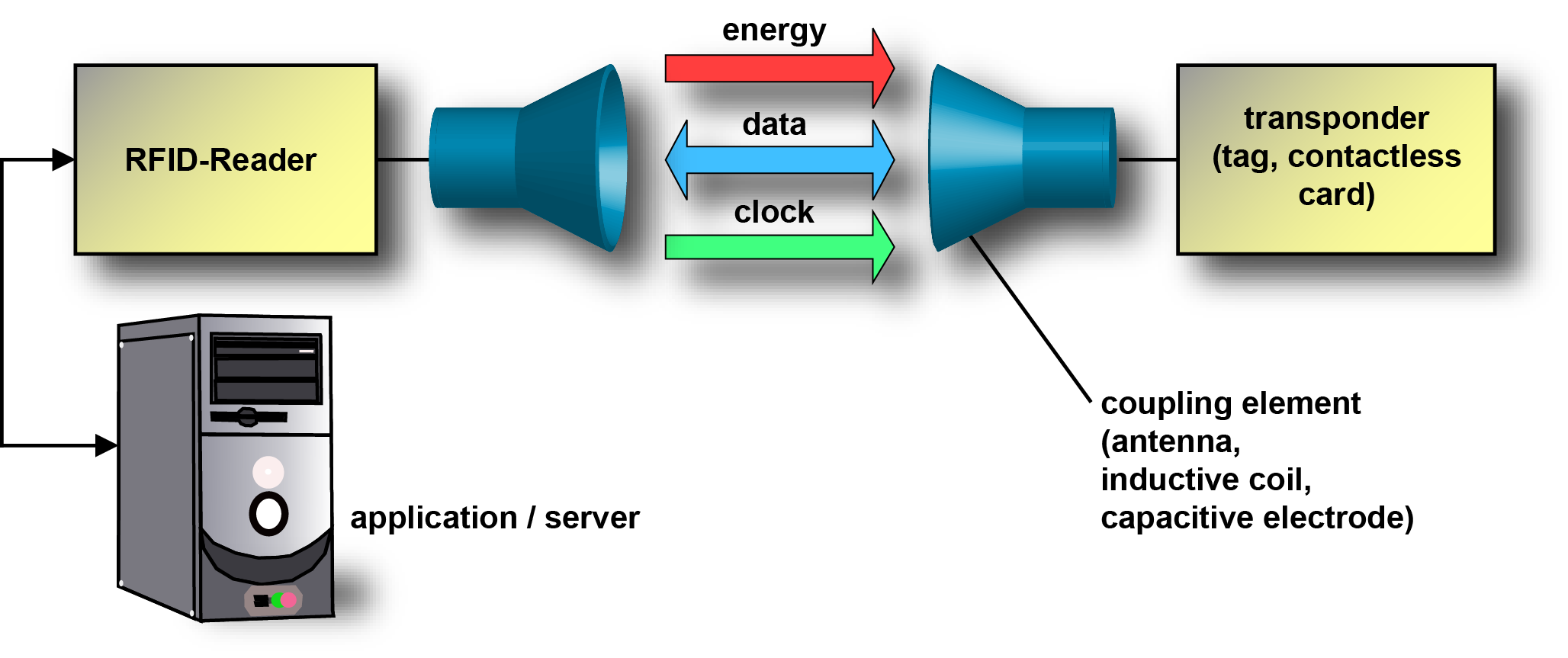
Picture: The reader and the transponder are the main components of every RFID system
A reader typically contains a high frequency module (transmitter and receiver), a control unit and a coupling element to the transponder. In addition, many readers are fitted with an additional interface (RS 232, RS 485, ...) to enable it to forward the data received to another system (PC, robot control system, ...).
The transponder, which represents the actual data carrying device of an RFID system, normally consists of a coupling element and an electronic microchip. When the transponder, which does not usually possess its own voltage supply (battery), is not within the response range of a reader it is totally passive. The transponder is only activated when it is within the response range of a reader. The power required to activate the transponder is supplied to the transponder through the coupling unit (contactless) as is the timing pulse and data.
Operating principles of RFID systems
There is a huge variety of different operating principles for RFID systems. The picture below provides a short survey of known operation principles (The numbers refer to the relating chapters in the book).
The most important principles - 'inductive coupling' and 'backscatter coupling' are described more detailed below.
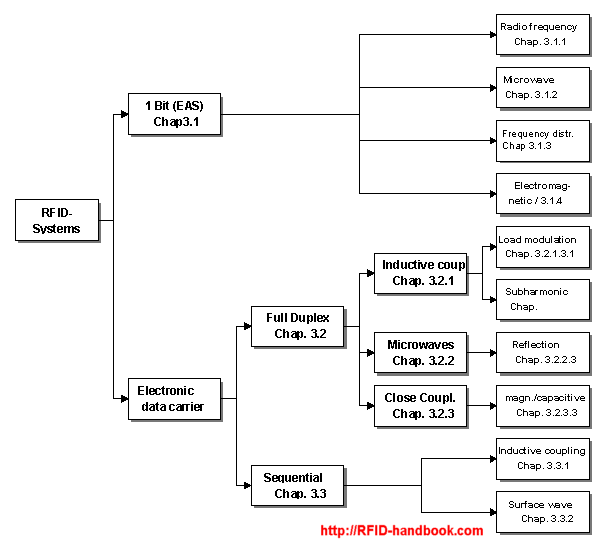
Picture: The allocation of the different operating principles of RFID systems into the chapters of the English eddition.
Inductive Coupling (3.2.1)
An inductively coupled transponder comprises of an electronic data carrying device, usually a single microchip and a large area coil that functions as an antenna.
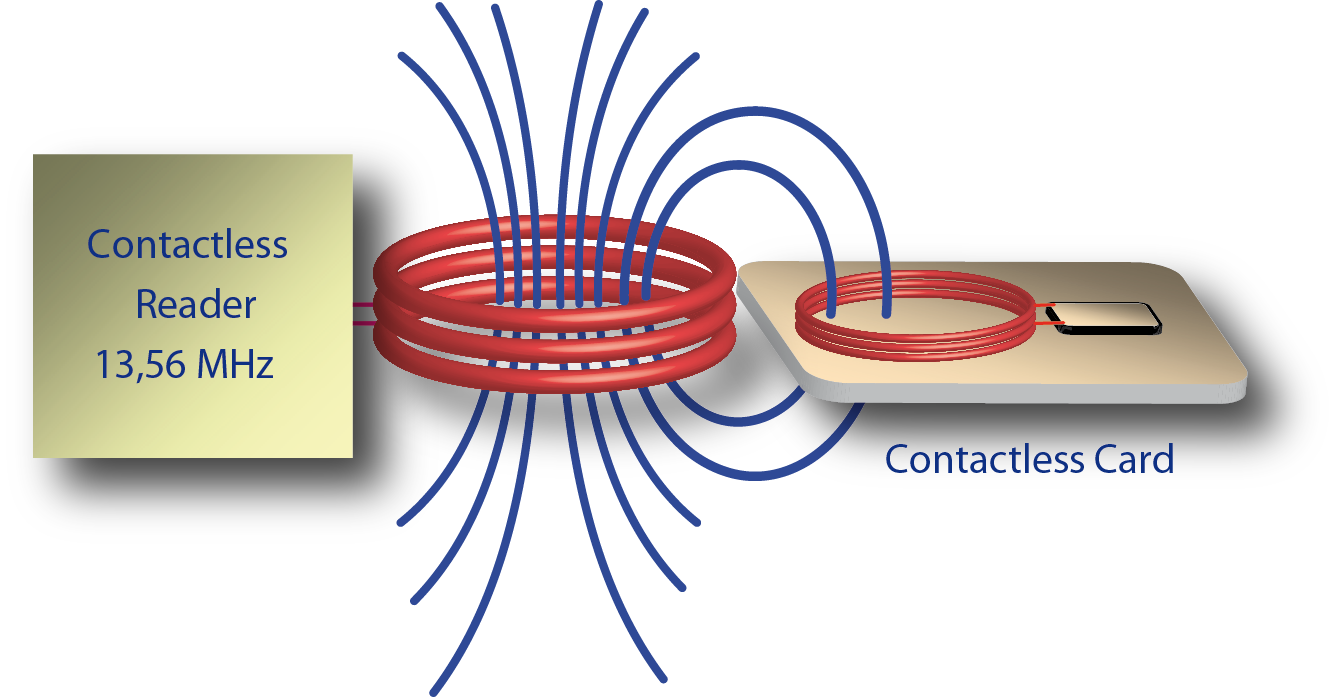
Picture: Iductive coupled RFID-System
Inductively coupled transponders are almost always operated passively. This means that all the energy needed for the operation of the microchip has to be provided by the reader. For this purpose, the reader's antenna coil generates a strong, high frequency electro-magnetic field, which penetrates the cross -section of the coil area and the area around the coil. Because the wavelength of the frequency range used (< 135 kHz: 2400 m, 13.56 MHz: 22.1 m) is several times greater than the distance between the reader's antenna and the transponder, the electro-magnetic field may be treated as a simple magnetic alternating field with regard to the distance between transponder and antenna (see the chapter "Physical Principles – Transition from Near Field to Far Field" (4.2.1.1.) for further details).
A small part of the emitted field penetrates the antenna coil of the transponder, which is some distance away from the coil of the reader. By induction, a voltage Ui is generated in the transponder's antenna coil. This voltage is rectified and serves as the power supply for the data carrying device (microchip). A capacitor C1 is connected in parallel with the reader's antenna coil, the capacitance of which is selected such that it combines with the coil inductance of the antenna coil to form a parallel resonant circuit, with a resonant frequency that corresponds with the transmission frequency of the reader. Very high currents are generated in the antenna coil of the reader by resonance step-up in the parallel resonant circuit, which can be used to generate the required field strengths for the operation of the remote transponder.
The antenna coil of the transponder and the capacitor C1 to form a resonant circuit tuned to the transmission frequency of the reader. The voltage U at the transponder coil reaches a maximum due to resonance step-up in the parallel resonant circuit.
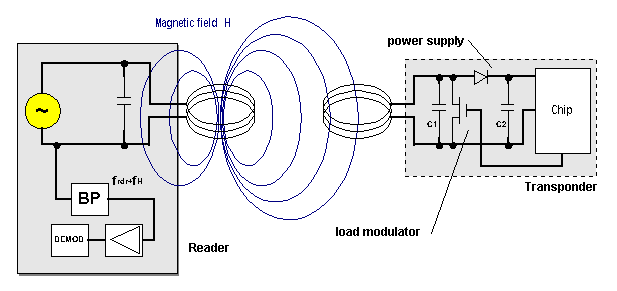
Picture: Operation principle of an inductive coupled system
As described above, inductively coupled systems are based upon a transformer-type coupling between the primary coil in the reader and the secondary coil in the transponder. This is true when the distance between the coils does not exceed 0.16 l, so that the transponder is located in the near field of the transmitter antenna (for a more detailed definition of the near and far fields, please refer to the chapter "Physical Principles").
If a resonant transponder (i.e. the self-resonant frequency of the transponder corresponds with the transmission frequency of the reader) is placed within the magnetic alternating field of the reader's antenna, then this draws energy from the magnetic field. This additional power consumption can be measured as voltage drop at the internal resistance in the reader antennae through the supply current to the reader's antenna. The switching on and off of a load resistance at the transponder's antenna therefore effects voltage changes at the reader's antenna and thus has the effect of an amplitude modulation of the antenna voltage by the remote transponder. If the switching on and off of the load resistor is controlled by data, then this data can be transferred from the transponder to the reader. This type of data transfer is called load modulation.
To reclaim the data in the reader, the voltage measured at the reader's antenna is rectified. This represents the demodulation of an amplitude modulated signal. An example circuit is shown in the chapter "Reader – Low Cost Layout".
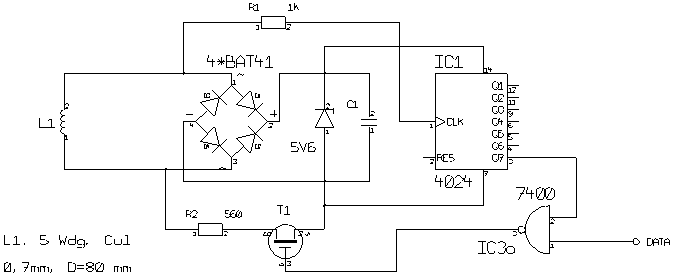
Picture: sample circuit of the power supply and load modulator in a transponder
Picture above: If the additional load resistor in the transponder is switched on and off at a very high elementary frequency fH, then two spectral lines are created at a distance of ±fH around the transmission frequency of the reader, and these can be easily detected (however fH must be less than fREADER). In the terminology of radio technology the new elementary frequency is called a subcarrier. Data transfer is by the ASK, FSK or PSK modulation of the subcarrier in time with the data flow. This represents an amplitude modulation of the subcarrier.
Backscatter Coupling (3.2.2)
We know from the field of RADAR technology that electromagnetic waves are reflected by objects with dimensions greater than around half the wavelength of the wave. The efficiency with which an object reflects electromagnetic waves is described by its reflection cross-section. Objects that are in resonance with the wave front that hits them, as is the case for antenna at the appropriate frequency for example, have a particularly large reflection cross-section.
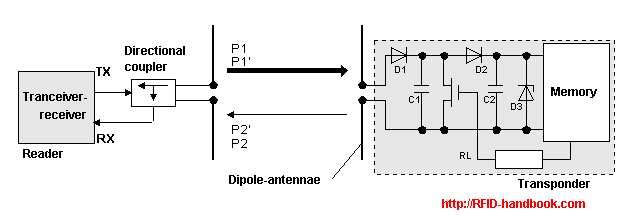
Picture: Operation principle of a backscatter transponder
Power P1 is emitted from the reader's antenna, a small proportion of which (free space attenuation) reaches the transponder's antenna. The power P1' is supplied to the antenna connections as HF voltage and after rectification by the diodes D1 and D2 this can be used as turn on voltage for the deactivation or activation of the power saving "power-down" mode. The diodes used here are low barrier Schottky diodes, which have a particularly low threshold voltage. The voltage obtained may also be sufficient to serve as a power supply for short ranges.
A proportion of the incoming power P1' is reflected by the antenna and returned as power P2. The reflection characteristics (= reflection cross-section) of the antenna can be influenced by altering the load connected to the antenna. In order to transmit data from the transponder to the reader, a load resistor RL connected in parallel with the antenna is switched on and off in time with the data stream to be transmitted. The amplitude of the power P2 reflected from the transponder can thus be modulated (à modulated backscatter).
The power P2 reflected from the transponder is radiated into free space. A small proportion of this (free space attenuation) is picked up by the reader's antenna. The reflected signal therefore travels into the antenna connection of the reader in the "backwards direction" and can be decoupled using a directional coupler and transferred to the receiver input of a reader. The "forward" signal of the transmitter, which is stronger by powers of ten, is to a large degree suppressed by the directional coupler.
The ratio of power transmitted by the reader and power returning from the transponder (P1 / P2) can be estimated using the radar equation (for a more detailed explanation, please refer to the chapter 4 "Physical Principles" of the RFID-handbook).
Inga kommentarer:
Skicka en kommentar